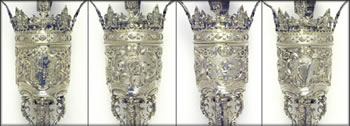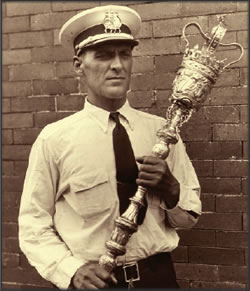
|

Fall 2005The Norfolk City Mace - A Miraculous History
|
| The Norfolk City Mace is one of Norfolk’s oldest citizens, presented to the Borough of Norfolk by Royal Lt. Governor Robert Dinwiddie on 1 April 1754. |  |
| Like a cat with nine lives,
the Norfolk Mace has survived some scrapes. It has been buried for
safe keeping two times – during the American Revolution and the Civil War. |
The original mace was a medieval war club. It was the fi rst weapon devised specifi cally for use in battle, with a spiked head for use against adversaries wearing the newly-invented chain mail armor. The Sergeant-at-Arms carried a mace during processions of state to protect royalty and other important persons. As more effective weapons were developed and the duties of the Sergeant-at-Arms became more ceremonial, the construction and design of the mace evolved, with precious metals replacing the utilitarian wood and iron, and spikes giving way to jewels and elaborate designs.
Norfolk’s Mace was crafted by English silversmith Fuller White in 1753. White incorporated symbolism into the design, to refl ect the British world view of the day. A large British crown sits atop the bowl of the Mace, which is adorned with the French Fleur-de-lis, the Harp of Ireland, Rose of England and Thistle of Scotland. To drive home the point that England considered each of these countries to be a part of the British Empire, a small crown is carved above each symbol.
 |
| Designs around the bowl of the Norfolk Mace include the coat of arms of England’s George II ; the rose and thistle representing England and Scotland; the fleur-de-lis of France; and the harp of Ireland. |
It was lost after being moved from the failed Exchange Bank of Norfolk in 1885, only to turn up in a storeroom at police headquarters in 1894. Proposals were made in 1794 and 1836 to alter its design in order to divest it of its “kingly” symbolism, but it carried on unscathed.
It was turned over to Norfolk National Bank (a predecessor of Bank of America) in the 1890s. In 1935, as the National Bank of Commerce, the bank commissioned a glass display case for the Mace. The case was positioned over a vault, where the Mace rested during non-business hours, and from which it was raised at opening each day to greet customers.
Two replica maces were custom-made in 1952 to preserve the 200- year-old relic from future handling. The bank retained the original and presented the replicas to Norfolk City Council and the Norfolk Museum of Arts and Sciences (now the Chrysler Museum of Art) for ceremonial use and display. Bank president John Alfriend carried a replica to England in 1956 to promote the upcoming 350th anniversary of the Jamestown settlement. The mace was a hit, and Alfriend was made an honorary member of the English Guild of Mace Bearers.
 |
| Officer Adrian D. Cooper, of the Norfolk Police
Department, prepares to participate in a parade on 16 August 1932,
part of the festivities commemorating the 250th anniversary of the
1682 founding of Norfolk. |
The Mace has shared the stage with three American presidents – John Tyler, Theodore Roosevelt and Dwight D. Eisenhower. When festivities at Jamestown Island in 1857 marked the 250th anniversary of the first permanent English settlement, the Mace was there. It was at Jamestown one hundred years later, at the request of guest of honor Queen Elizabeth II, who had heard about our Mace and said that she would like to see it. Custody of the Mace was transferred to the Chrysler Museum of Art in 1989, where it is on permanent display today. A replica Mace is also exhibited at the new Norfolk History Museum.
You Are Here: Home
> Essays and Artifacts > Insights
from The Courier > Fall 2005 Selections |